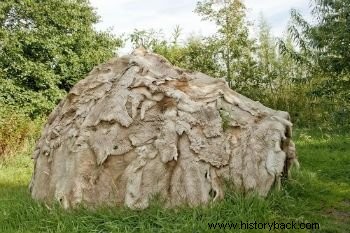The Mesolithic Period corresponds to the period of prehistoric transition between the Paleolithic (Age of Pedra Lascada) and the Neolithic (Age of Pedra Polida). This transition happened slowly and gradually, the Mesolithic being the period that encompasses this change.
 Mesolithic Period Hut, Scotland, UK
Mesolithic Period Hut, Scotland, UK
Note that while the term Paleolithic means "Ancient Stone Age" and Neolithic "New Stone Age", the Mesolithic term means "Middle Stone Age" or "Between Stones".
Mesolithic Divisions
This period is divided into two phases:
- Epipaleolithic :corresponds to the late and post-glacial phase of the Paleolithic and early Mesolithic phase.
- Protoneolithic :corresponds to the late Mesolithic and early Neolithic phases.
Features
It was during the late Paleolithic and early Mesolithic (around 10,000 BC to 5,000 BC) that the earth underwent geological and climatic changes, which led to several transformations in the life of prehistoric man. One of the last glaciations occurred and the temperature became milder allowing a new life for the population.
In this way, the Paleolithic nomadic man who lived his life walking in search of shelter and food, was inserted in a very hostile climate, called the “Ice Age”. Thus, in the face of so many weather conditions, in order to survive, the Paleolithic man inhabited caves to protect himself from extreme cold, as well as to escape from the ferocious animals.
Already in the Mesolithic, men, called stationary nomads (related to the seasons) often inhabited caves during the winter and in the summers they camped near the rivers, which led them to learn fishing techniques and build new tools (hooks). , arrows, nets, harpoons, etc.). In short, Paleolithic cave life was replaced by outdoor life.
This was essential for them to start to settle down (stay in one place), which was gradually resolved by factors such as the amelioration of the Earth's climate. In such a way, in the Mesolithic they already begin to build small shelters of stone, wood, leaves.
This really changes with the “Neolithic Revolution”, where man becomes sedentary, and acquired agricultural techniques, and begins to domesticate some animals, in addition to building houses.
Thus, it was during the Mesolithic period that the discovery of fire provided a better life for men, whether to scare away wild animals, light up the nights, protect from the cold, cook, among others.
In addition, in the Stone Age (the union between the Paleolithic, Mesolithic and Neolithic) man uses stone as the main resource to produce tools and other necessary utensils, which was only modified later, in the “Age of Metals”.
Although the Neolithic period is indicated as the period of construction of villages, division of labor (men hunted and women took care of children) and social organization, it is during the Mesolithic period that man begins to get used to new relationships and the appearance of family nuclei, which were made later, in the Neolithic Period or Polished Stone Age.
Art in the Mesolithic
Art in the Mesolithic period is a little different from the previous period, the Paleolithic or Chipped Stone Age, in a way that open-air art begins to emerge, from abstract schemes, with the development of the rationalization of man, although many representations of that period were figurative, mainly of human figures.
